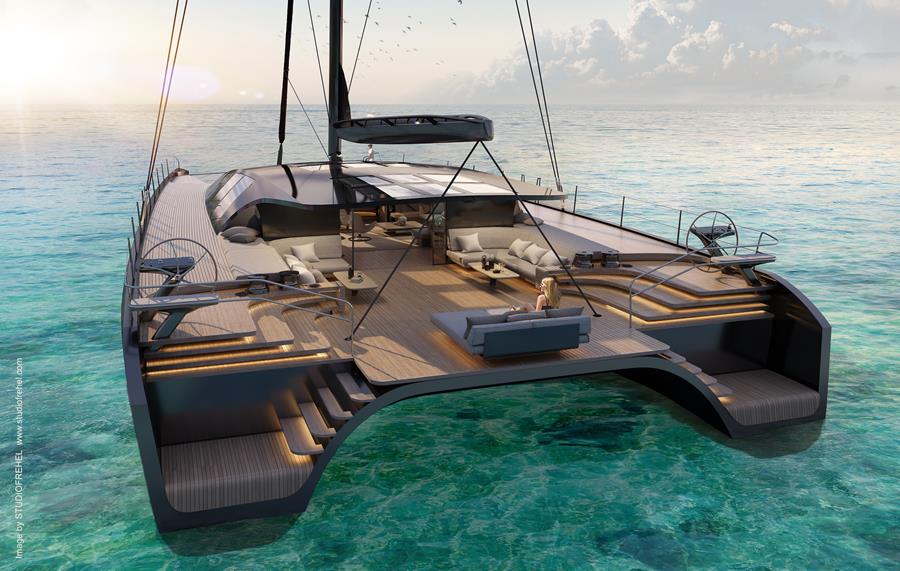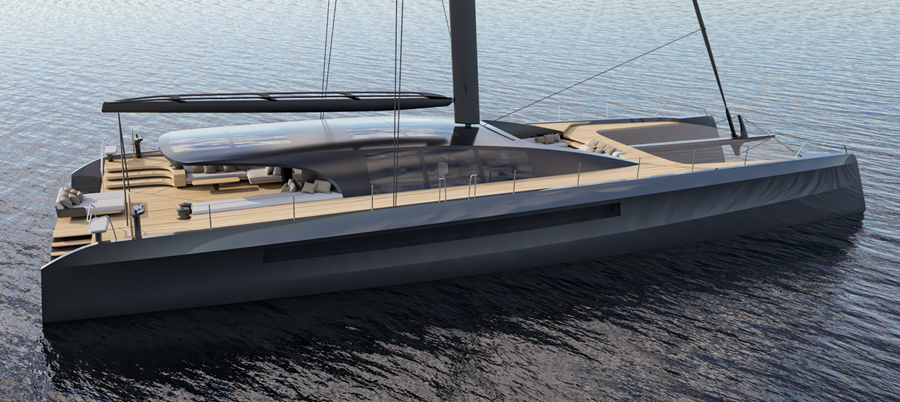Design insight
BlackCat Superyachts founders discuss the latest design features of its high-performance luxury model, the BlackCat 30.
03 August 2020
The BlackCat 30 catamaran will be the third model of the ground-breaking BlackCat range since the high-performance luxury superyacht catamarans brand was launched in 2016.
The BlackCat range is the brainchild of champion Australian yachtsman Mitch Booth, with design by world-renowned superyacht design studio, Malcolm McKeon Yacht Design. Mitch has spent more than forty years racing virtually every type of catamaran, has skippered and managed America’s Cup campaigns, and holds over a dozen world titles and sailing awards.
The BlackCat 30 has an open-plan and supremely luxurious interior design by m2atelier and there’s accommodation for eight guests in six ensuite cabins.
Following the announcement from BlackCat Superyachts that McConaghy is their build partner of choice for the BlackCat 30, Mitch Booth and Mark Evans answer some of the key questions surrounding the construction of this groundbreaking, high-performance 30-metre catamaran.
Interview with Mitch Booth – Founder of BlackCat Superyachts
Preliminary performance indications are for a 20-knot cruising speed and a maximum speed of 32 knots. How will the BlackCat 30 achieve this?
Large multihull sailboats are high performance by nature, as long as weight is kept low. The BlackCat 30 is built from carbon fibre, which results in a very light hull with a particularly hydrodynamic form.
What aspects of the BlackCat 30’s design and construction aid a reduction in emissions?
Due to the BlackCat 30’s low drag and light weight, it requires smaller engines for motoring and easily achieves a comfortable cruising speed. Fuel burn is inherently low, but the BlackCat 30 can also be specified with a hybrid system that derives power from solar and wind sources, which is fed into a large lithium iron battery bank to power onboard systems.
It seems every sailing superyacht shipyard now has a multihull concept on the table.
What sets the BlackCat 30 apart?
BlackCat is not your average multihull. Our design and equipment partners bring an incredible wealth of knowledge in the mix; we are working with the best in the world.
The balance between building an ultra strong, lightweight yacht that sails like a thoroughbred, with the luxurious comfort of a modern superyacht, is not an easy task.
We believe BlackCat Superyachts are unique in this aspect, and will deliver the world’s best-performing sailing superyacht.
The cruising catamaran market is the largest growth sector in midsize yachts today. We believe this trend will continue and eventually will become common throughout the superyacht sailing scene. The large volume and stable platform a BlackCat multihull provides is the logical solution for comfortable cruising.
Mark Evans – Managing Director of McConaghy Boats
What are the biggest challenges with building a Cat of this size and nature, and how will you overcome them?
Building a vessel of this size is not new to McConaghy. The current economic climate will be a hindrance in securing orders, but our pricing advantage over the European yards should help remove that barrier.
How will McConaghy’s experience in the construction of lightweight composite yachts benefit the build of the BlackCat 30?
Reducing weight, optimising construction and enhancing performance are part of McConaghy’s DNA. This philosophy – and methodical mindset – has garnered McConaghy Boats over fifty years of composite construction experience.
What are the benefits of building this Cat in carbon fibre, as opposed to aluminium?
This catamaran will be lighter, stronger, stiffer and, thanks to its two-skin construction, will be more robust and safer, should it suffer impact. A lighter vessel has obvious benefits when it comes to performance and energy efficiency.
The reduced, ongoing maintenance costs are also an appealing factor – the BlackCat 30 will be easier to clean and not suffer from corrosion like an aluminium counterpart.







